How To Make My Salesforce App Lightning Ready
Learning Objectives
After completing this unit, you'll be able to:
- Describe the benefits of Lightning apps.
- Create a Lightning app with custom branding.
- List two best practices for planning Lightning apps for your org.
What Is a Lightning App?
An app is a collection of items that work together to serve a particular function. In Lightning Experience, Lightning apps give your users access to sets of objects, tabs, and other items all in one convenient bundle in the navigation bar.
Lightning apps let you brand your apps with a custom color and logo. You can even include a utility bar and Lightning page tabs in your Lightning app. Members of your org can work more efficiently by easily switching between apps. What's most important to sales reps? Accounts, events, and organizations. How about sales managers? Reports and dashboards make the top of the list.
Let's jump into the details.
Each Lightning app has a navigation bar at the top of the page, letting your users:
- Find what they need using item names for easy recognition
- Complete actions and access recent records and lists with a single click
- Personalize the navigation bar to suit the unique way they work
Think of the navigation bar as a container for a set of items and functionality. It's always there, but the items within it change based on the app you're using. 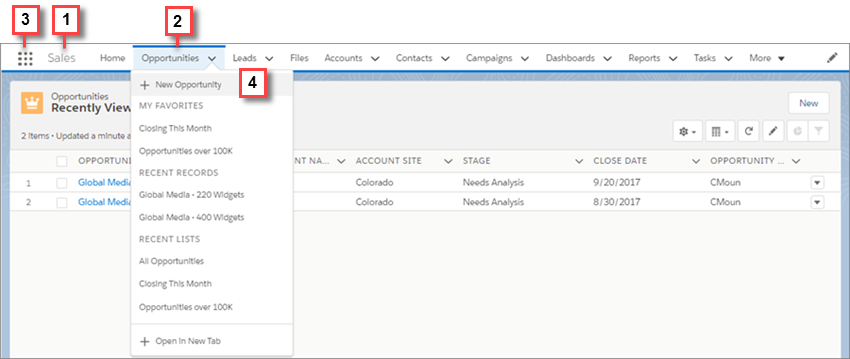
- The app name (1) displays on the left side of the navigation bar and custom colors and branding (2) make each app unique and easy to identify.
- Your users can access other items and apps by clicking the App Launcher icon (3).
- Your users can create records and access recent records and lists directly from the navigation bar (4) for items like Opportunities.
So what things can you put in a Lightning app?
- Most standard objects, including Home, the main Chatter feed, Groups, and People
- Your org's custom objects
- Visualforce tabs
- Lightning component tabs
- Canvas apps via Visualforce tabs
- Web tabs
You can even include Lightning page tabs and utilities like Lightning Voice. If your org uses utility features, you can enable a utility bar in your app that allows instant access to productivity tools, like integrated voice, in the Lightning Experience footer.
You can also build your own on-demand apps by grouping items into new custom apps.
To switch between apps, users can use the App Launcher (![]() ). This makes it easy for users to switch contexts and still have access to the items, objects, and pages they need most.
). This makes it easy for users to switch contexts and still have access to the items, objects, and pages they need most. 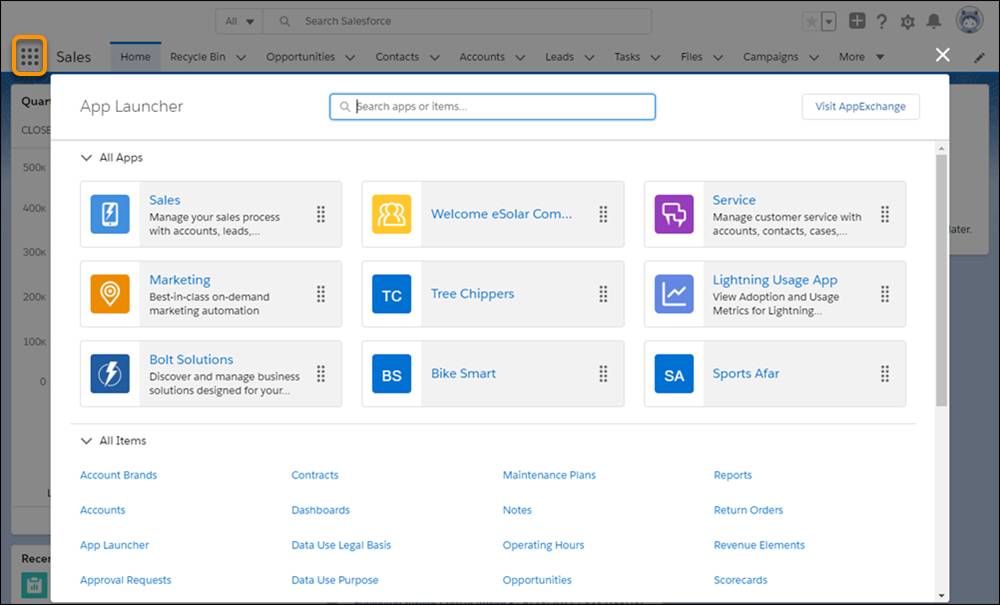
Meet the Lightning Experience App Manager
The App Manager is your go-to place for managing apps for Lightning Experience. It shows all your connected apps and Salesforce apps.
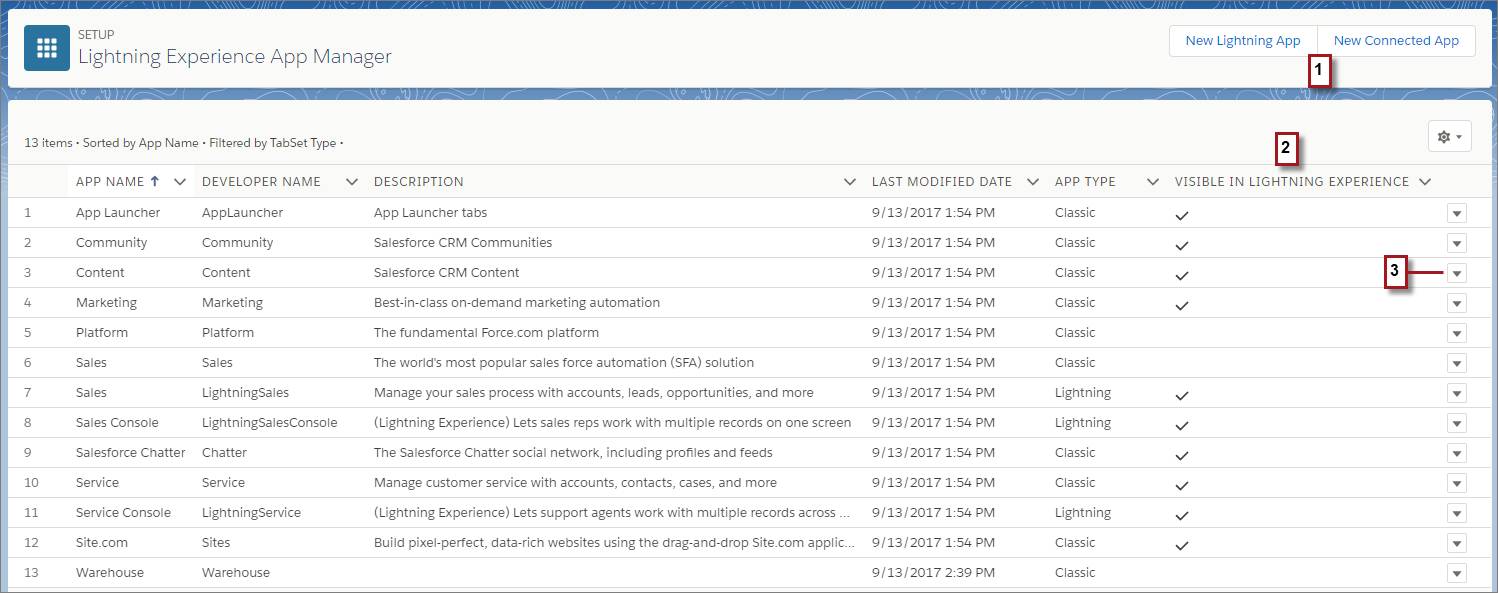
Use the Lightning Experience App Manager to:
- View all your Salesforce apps.
- Create Lightning apps or connected apps (1).
- See which apps are visible in Lightning Experience (2).
- Easily manage apps (3).
What does that "Visible in Lightning" column mean?
You can see in the App Manager that there are two types of apps: Classic and Lightning. A checkmark in the Visible in Lightning Experience column means that the app is accessible in Lightning Experience via the App Launcher and is fully functional.
Classic apps that don't have a check mark in the Visible in Lightning column are enabled only for our Salesforce Classic UI. Because you're working in Lightning Experience, you won't find those Classic-only apps in the App Launcher. Classic apps marked as visible in Lightning Experience are fully usable in Lightning Experience, but they don't take advantage of the app enhancements that Lightning Experience offers.
Create a Lightning App
Creating and editing a Lightning app is a cinch. As Ursa Major Solar's admin, Maria needs an app that puts everything about customer energy assessments at her consultants' fingertips. Let's dive right in and try it out. In a few simple steps, you can give an app a name, set its primary color, upload a logo, specify which items appear in the app's navigation bar, and assign the app to user profiles.
- From the Home tab in Setup, enter
Appin the Quick Find box, then select App Manager. - Click New Lightning App.
- Walk through the Lightning App Wizard, creating an app with these parameters.
App Name Energy Consultations Description Track energy audits and product recommendations. Image Your choice!Use a JPG, PNG, BMP, or GIF image that's smaller than 5 MB. For best results, upload an image that's 128 by 128 pixels. Images larger than the maximum display of 128 by 128 pixels are automatically resized. Primary hex color value #FA8B05 App options Leave as-is. Utility items Don't add any. Navigation items to include in the app (in this order) Home, Chatter, Groups, Energy Audits, Accounts, Contacts, Products, Tasks Assigned to user profile System Administrator Maria would assign it to her consultants' user profile, but for our purposes, it's easier to test if we set it to System Administrator.
- Click Save and Finish to exit the wizard.
- From the App Launcher (
 ), find and select Energy Consultations.
), find and select Energy Consultations.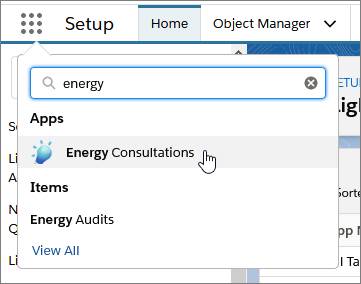
- Check out the new app! It's got all the custom branding you gave it: a custom icon in the upper left and the custom color you assigned to it. Because Home is first in the navigation bar, it becomes the first page your users see when they open the app.
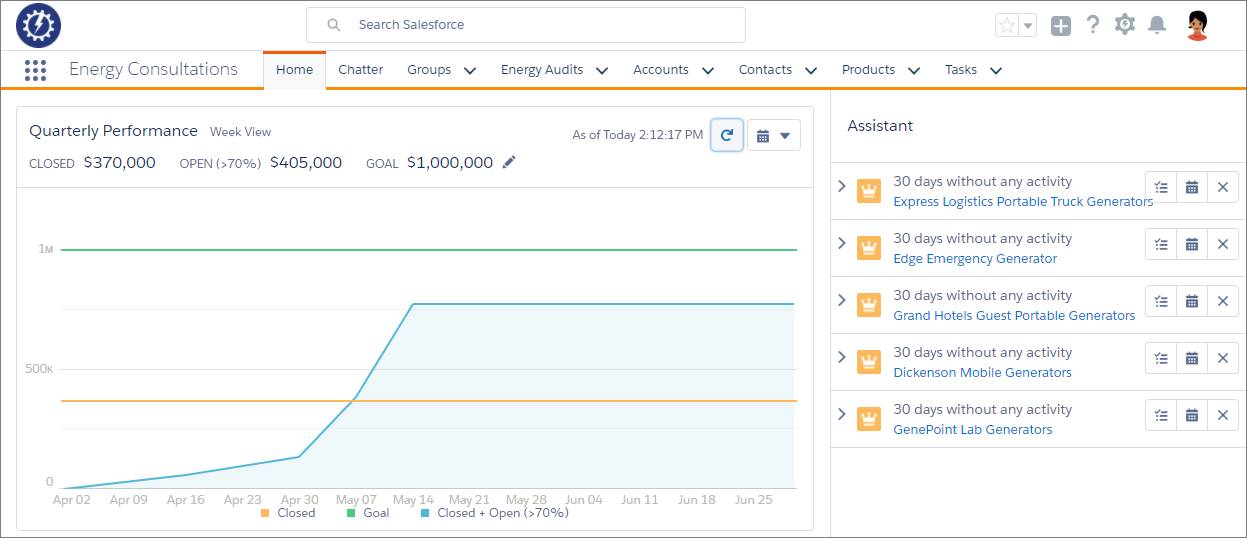
Nice work! Now you're ready to create your own custom Lightning apps.
Tips for Creating Apps in Lightning Experience
It's time for the fun part: deciding how to set up Lightning apps for your users. Here are some tips for planning Lightning apps for your org.
Talk to your users. Ask them what their priorities are. Customizing tabs in apps gives you a unique opportunity to engage with your users. Each group of users has its own priorities. Find out which objects and items represent their highest priorities.
- Ask users to post feedback to a Chatter group.
- Publish polls.
- Schedule lunch sessions. Everyone likes a free lunch, and nearly everybody is happy to express their opinion.
Create a master list of objects that everyone in your org wants. Then trim down the list for each group—sales reps, sales managers, execs, and so on. The menus for every user group share some common objects, like Home, Tasks, and Feed. Keep the high-priority items for each group at the top. Put low-priority items at the bottom, or remove them altogether. Users can always go to the App Launcher to get the items they use less often.
How To Make My Salesforce App Lightning Ready
Source: https://trailhead.salesforce.com/en/content/learn/modules/lex_customization/lex_customization_apps
Posted by: churchaceeakell.blogspot.com

0 Response to "How To Make My Salesforce App Lightning Ready"
Post a Comment